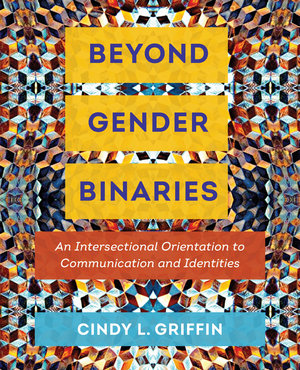By Cindy L. Griffin, author of Beyond Gender Binaries: An Intersectional Orientation to Communication and Identity
Intersectionality is one of the most transformative orientations we can assume as teachers, scholars, researchers, and activists. Like my colleagues across the disciplines, and the students in my classes, I struggle with oversimplified and binary understandings of who we are and how we move about in the world: male or female, black or white, straight or gay, able body or disabled body, wealthy or poor, and so on. Those either/or categories rarely make any sense in today’s complex world and they only serve to constrain and mislead. Even though these binaries have become entrenched, we can get past them and communicate in intersectional ways.

In my new book, Beyond Gender Binaries: An Intersectional Orientation to Communication and Identity, I develop and showcase the tools we need to not just say our work is intersectional, but to actually do work that is intersectional. Using the work of early theorists (Combahee River Collective, Crenshaw, Hill Collins, Williams, Alexander, Garland-Thompson, and more) I engage the conversations we have about our complex identities and differences in intersectional ways. To help us reconceptualize and recalibrate our communication, I turn to those early intersectional theories and orientations, as well as to more recent thinkers (Delgado, Rios, Muñiz, Wing Sue, Leonardo, Kimmel and Ferber, Allen, Carrillo Rowe, Chávez, and more) to talk about communication, feminisms, identity and privilege, safety and violence, hegemony and colonialization. The result is a book that helps scholars, and our students, develop the intersectional tools and discourses we hunger for.
As I was writing Beyond Gender Binaries, I constantly asked myself whether I was crafting a book that would give scholars and students interested in intersectional orientations the teaching and learning tools they need to engage this complex orientation. Going from a binary to an intersectional framework in any course can require a significant restructuring of that course, moving away from what is familiar and into discourses of complexity. Rather than create something obscure, I knew I wanted to make the ideas in the book as engaging and available to as wide a range of people as I could, all the while keeping them true to their nuances and complexities.Knowing this, I filled the book with helpful resources for scholars and students. Thorough references to TED talks, social media posts, blogs, books (novels and scholarly), articles, and films are included at the end of every chapter. Additionally, each chapter in the book focuses on clear sets of questions and outcomes. Chapters can be engaged in the sequence they are presented, or rearranged according to instructor preference. In every chapter, to compliment and illustrate the carefully researched text, I provide historical and contemporary narratives, examples, tables and images. I also include several “Guide to Communication” features, which recap information and ideas, ask readers to discuss key aspects of that information, and challenge them to stay present, accountable, and open to intersectional ways of communicating. And lastly, I provide a rich instructors’ resource manual that includes definitions of relevant terms and vocabulary, chapter outlines, exam questions, power point slides with active links to the resources offered in the chapters, suggestions for activities and addressing conflict or confusion, and my own email contact information.
Although I have written and published many other projects, Beyond Gender Binaries was, without a doubt, my most challenging project. But it was also the most rewarding because, as I wrote, I was constantly accountable for and responsible to the nuances and complexities of an intersectional orientation to identity and communication, and to what intersectionality actually makes available to us.
Communication often is used, and defined, in a binary manner. Too often, communication is seen as an attempt to convince others of the rightness of our ideas, and, by extension, the incorrectness of someone else’s view: there is a right and a wrong. When viewed through an intersectional lens, however, communication can be defined as standing in a matrix, a matrix of identities that relate differentially to power, privilege, access and agency. Opening ourselves to the reality and nuances of this matrix, and finding ways to communicate respectfully and with curiosity within this matrix, is the key goal of my book.
